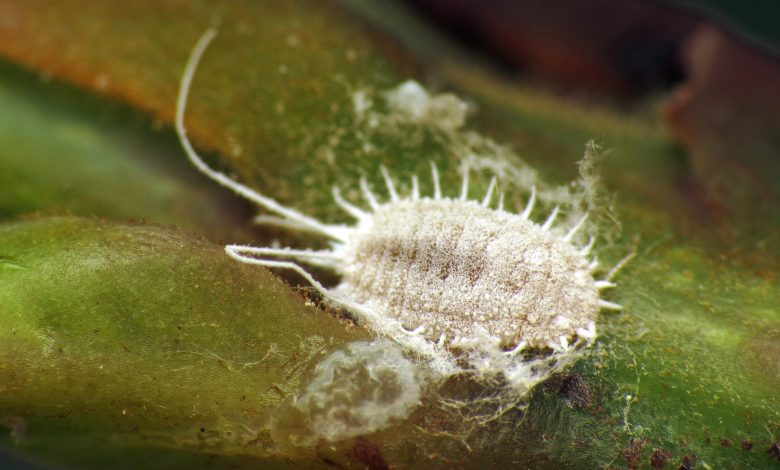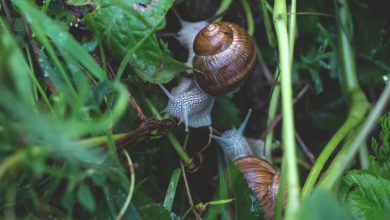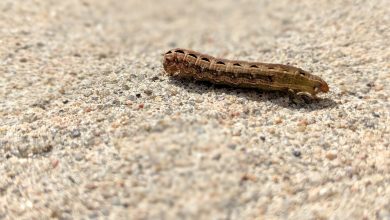How to Get Rid of Mealybugs

When it comes to our gardens, we hate to see any plant or flower struggle. After working so hard to maintain our outdoor oasis, knowing that there’s something wreaking havoc can cause a lot of stress and frustration.
It can be especially displeasing to find out that some sort of pest or disease is slowly killing our gardens, sometimes without us realizing it for a long time. Of course, there is no foolproof way to stop annoying infestations from entering this space; however, possessing the correct knowledge about garden pests and how to prevent or stop them is very helpful.
One pest that is particularly displeasing to see is the mealybug. Sometimes it might look like your plants don’t stand a chance, but that’s not true. With some due diligence and patience, you can save your labors of love from these pesky plant suckers.
If you’re dealing with or trying to prevent mealybugs, the following information will tell you everything you need to know about them. This way, you have a better chance of protecting your garden, and you’ll know how to respond the second you see one.
The Mealybug
Mealybugs are a part of the Pseudococcidae family. They are unarmored scale insects, which tend to be found in areas that are warm and moist. Their main goal in life is to seek out food, which happens to be provided by indoor and outdoor vegetation.
Mealybugs work to suck out the juices of plants, trees, and other greenery, slowly killing the plant in the process. They are not picky when it comes to their food, which means they will feed on greenhouse plants, subtropical plants trees, and any indoor plants you have.
Not only can they kill your plants through feeding, but they are also known to be carriers of a range of diseases that can also affect the health of your plant. Seeing mealybugs is not a nice surprise, and they can sometimes show up seemingly overnight.

What Does a Mealybug Look Like?
If you look closely at your plant, you might notice very tiny, white pieces sitting on the leaves. At first, you might misjudge them for tiny pieces of cotton; however, they are much more problematic than that.
All mealybugs are white, with the females appearing as nymphs and lacking wings. They have very tiny legs all around their body and move very slowly. Male mealybugs are smaller than the females, and they are more like gnats. However, male mealybugs have wings and can travel much more efficiently.
The reason these bugs are white is because of the wax that they secrete through special glands on the top and the sides of their bodies. Another garden pest that many gardeners are familiar with are aphids, and these two pests are often confused for one another.
While most mealybugs are white, some species can also look more pink, yellow, or light green. In most cases, though, the white coloring is what you should be looking for.
Mealybug Life Cycle
Mealybugs have a fairly basic lifestyle that starts out in egg formation. From there, the mealybug breaks free from the shell and moves on to larvae and adult stages.
When a female lays these eggs, she can lay up to 500 at one time in her waxy secretion. The egg sac is white and looks to be made of cotton to the naked eye. It will take ten days for the eggs to finally hatch; from there, the larvae will spread all over the host plant looking for food.
In warm climates, female mealybugs are far more active than in cooler regions. In hot locations, these females can produce as many as eight generations in a year. In cooler locations, they will only produce one or two.
In comparison to aphids, mealybugs lay far fewer eggs and reproduce much less. This is why you have a good chance of halting their spread if you can stop the females before they lay their eggs.
What Do Mealybugs Do?
The male mealybug is not as much of a threat as the females since the male’s only job in life is to fertilize the females. In their early stages, males will do some feeding, but as adults, they do not feed at all.
The females, on the other hand, are the ones gardeners need to worry about, as they are the ones who are doing the feeding on your plants. Females will attach themselves to an appropriate plant and then secrete a layer of wax. This wax is there for protection while the female feeds on the area.
The females are interested in the plant’s sap, and they will search for it in the crevices of plants and in the roots. This is often why they are so hard to spot in the beginning; they sit in the folds of the plant or at the bottom of the fruit.
If you suspect you have mealybugs, you might gently pull leaves away from the stem; mealybugs love to hide here as well. Oftentimes, you will not notice any difference until the plant begins to look like it is turning white because of all the mealybugs present.
Other than feeding, the female mealybug will be busy laying eggs. In some cases, the female will give birth to her eggs as she moves. In other species, however, the female will lay her eggs within the wax that she’s secreted onto the plant.
As the mealybugs move along your plant, they will leave behind a honeydew-like residue. This additional act is something that works to attract ants to the area. Ants love the honeydew residue that aphids and mealybugs produce.
If you see lots of ants coming to a plant’s site, this might be a sign that you’ve got a pest infestation that is attracting them there.
What Plants Are Most at Risk?
Mealybugs certainly have a taste for some specific plant life. The worst mealybugs that you can have are of the citrus type; this species can wipe out full crops of mango and are very hard to eradicate.
Other types of mealybugs will feed on ferns, cacti, papaya, orchids, sunflowers, sugarcane, pineapple, grapes, and coffee trees. Naturally, a lot of these plants are grown in warmer climates, but if they are transported with some mealybug infestations, the problem can persist in their new location.
Where Do Mealybugs Come From?
The pink hibiscus mealybug is native to India, but it wasn’t long before the pests were able to make their way all across the world. The presence of this pest was reported in Egypt in 1920, and it soon spread to the Caribbean in 1993.
Since then, the mealybug has become a common pest in North America and is a huge problem in states like Florida, Alabama, California, Mississippi, North Carolina, and South Carolina. The warmer climates are far more preferred, as well as the crops that grow in these places.
Yet with so many ways to access the rest of the world, mealybugs have made their mark in almost every country on the planet.
Unfortunately, figuring out how mealybugs arrived at your plant will remain a mystery. That’s because mealybugs are so tiny and easy to miss that they could have come into the area from several places.
It’s not nice to think about, but mealybugs can be transported on the plants you buy from the nursery, in the soil you purchase, and even on food that you’ve bought at the grocery store. Since mealybugs prefer warmer climates, they’re more likely to be found on indoor surfaces than outdoor ones.
If you suspect that you brought in the mealybugs from a specific kind of produce or plant, be sure to inspect these items thoroughly to make sure you’ve nailed down the source of the problem.
Are Mealybugs Harmful to Humans?
It’s certainly not fun having to remove mealybugs from your plants, but you shouldn’t worry if any of them touch your skin. Mealybugs can spread viruses, but this rarely occurs and has only been found with species that are attracted to grapevines.
If you’d like, you can choose to wear some form of protection like gloves when you’re removing mealybugs from your plants. They do not bite, but coming in contact with them might cause some skin irritation.
Their waxy secretion is more of a pain than anything since it can get on your clothes and be difficult to remove. Remove the bugs carefully, and be sure to wash your hands and clothing once you’re done.
The only true threat the mealybugs pose to humans is the ability to wipe out entire crops. Farmers with mealybug infestations know all too well the kind of economic losses that mealybugs can cause if they’re able to grow to high numbers.
Preventing Mealybugs

Look Before Buying
Since mealybugs are so common now, it’s not strange to find evidence of mealybugs on the plants you buy at grocery stores and nurseries. That being said, it’s important to be alert of potential issues before you choose to buy a plant.
This is especially true if you’re buying plants that mealybugs enjoy most, like orchids and succulents. Oddly enough, these are two of the most popular plants sold in grocery stores, which are also in close contact with food shipped from all over the world.
Before you purchase a plant, check for the signs of a mealybug infestation – and for any pest for that matter.
Consistently Check
Whenever you’re watering your plants or simply admiring them, take a few minutes to perform your due diligence. In some cases, only one or two females might be on your plant in the beginning, and catching them early can make all the difference between a few mealybugs and an infestation.
Ideally, you’ll want to catch any female mealybugs before they manage to lay their eggs. Once that happens, it will be a longer process to get rid of them. Instead, spend a few minutes every few days pulling back the leaves of your plants and checking crevices for any signs.
This small task will only take a few minutes, and it is worth it if you’re able to catch these pests before they spread. It’s especially ideal to keep checking in case you’re able to spot a mealybug egg sac that is yet to hatch. The ten-day window in which these eggs need to hatch is a prime time for you to catch and dispose of it.
After that, be sure to locate the females that are laying the eggs and dispose of them as well.
Low-Nitrogen
What attracts mealybugs to a plant the most is its higher levels of nitrogen. That being said, a plant that is getting more water than it needs or the wrong fertilizer can be a huge welcome mat for a mealybug.
When you’re purchasing fertilizer, look for something with lower contents of nitrogen. This can help to deter them from your plant. Additionally, make sure that all of your plants are potted in something that drains properly.
Lots of nice-looking pots are not designed with a drainage hole, so these should be avoided. Don’t be fooled by the way they look; they won’t look nice with an infested plant in them!
These kinds of pots do not allow excess water to drain out, which can create all kinds of problems, including pest infestations, root rot, wilting, and more. Every single plant, no matter what type, should be able to drain properly. Sitting water will entice bugs and send your plant into a downward spiral.
Succulents
Succulents have become increasingly popular in homes, both for their easy care, as well as their unique shapes and color. Unfortunately, succulents are one of the most sought-after plants for mealybugs.
Succulents are a favorite of mealybugs for several reasons. The first is that succulents have very thick, plump stems that are filled with fluid for mealybugs to enjoy. Additionally, succulents do best when they are in warm environments, which mealybugs also prefer.
For overwatered succulents, the excess water sits in the bottom of the pot and can begin to cause root rot. The moist area is a haven for mealybugs, who will love the warm air, increased nitrogen, and plump stems.
If you’re going to grow a succulent, you have to be sure that you are giving it the proper drainage it needs. That means growing them in pots with drainage holes and only watering them when the soil is completely dry. Even then, the plant may be okay for a while without water.
Succulents are known to have a lot of leaves and layers, which are perfect for mealybugs to hide. Even if you’re giving it the drainage it needs, take the time to check your succulent layers once in a while.

Getting Rid of Mealybugs
If you’ve already missed the boat on your mealybug arrival and you’re facing an infestation, there’s no need to panic. There are ways to remove the bugs without harming your plant, and in most cases, the plant can bounce back.
Leaf Removal
If only part of your plant has been exposed to mealybugs, you can remove these pieces without harming the rest of the plant. Remove any leaves and flowers that have the mealybug wax or bugs on them.
Alcohol
Some gardeners have expressed that alcohol seems to kill the mealybugs and stop their spread. You can use the alcohol on a swab and spread it around the plant or use a spray bottle. If you’re doing the latter, you might consider taking the plant outside to spray. Try to avoid using the spray bottle on healthy areas of the plant, though.
Water Spray
Aphids and mealybugs are similar in that they are quite easy to remove from plants. In this case, simply use a garden hose to blast the creatures off of the infected plant. Of course, this should only be done with your outdoor plants, or you can bring your indoor plants outside to spray with the hose.
Ladybugs
Ladybugs love to munch on the pests in your garden. They are especially interested in mealybugs and aphids, which means you have a warrior on your side.
If your infected plants are outdoors, consider introducing more ladybugs into the space. You can actually purchase ladybugs in a bag; however, it’s a good idea to release them in the evening when they are less likely to fly away.
In some cases, you might need to purchase a few bags of ladybugs to ensure that enough numbers stay. To entice the ladybugs to remain in the area, consider releasing them near the infested plant and offering other plants that ladybugs like to visit.
Another creature that will happily feed on the mealybug is a beetle known as the Cryptlaemus montrouzieri. This is another beetle in the ladybug family, and its common name is Mealybug Destroyer. This beetle is commonly dark brown with a redhead, making it slightly less attractive than the common ladybug.
However, introducing both of these species can be a way to combat mealybugs, and to inform them of the dangers of your garden if they ever try to re-visit.
Insecticides
If you have a small infestation on one or two plants, you can also consider using an organic insecticide. Real chemicals are far too harmful to the rest of your garden and to the planet in general. If you can, consider making a homemade insecticide that you can spray right onto the plant from top to bottom.
Tweezers
Some people don’t like the idea of touching mealybugs, which is no surprise. One way you might remove a small infestation from your indoor plants is to use a pair of tweezers. A small pair will easily pick up the creatures, which you can then drop in a bowl of warm, soapy water.
Alternatively, you can also use a small wet cloth to wipe the leaf of all mealybugs. This is also ideal for a smaller infestation. Be sure to use a cloth that is dark-colored, so you can easily see which parts of the cloth have already been used.
Toss the Plant
If you have come to a stage where your plant is too infested to save, then your best option may be to get rid of it. This is mostly an act to help spare the other plants in your home, which the mealybugs will likely move to once the current infected plant is dead. In some cases, this is the best route to ensure your other plants stay healthy and mealybug-free.
Keeping Your Plants Free of Pests
Lots of plant pests – not just mealybugs – will be attracted to plants that are moist and warm. If you’re caring for your plant properly, you shouldn’t experience too many problems with pests. However, they can always make their way into your home through other means, so it’s always good to be aware of their potential presence.
Keep an eye on your plants, and don’t be afraid to get your hands dirty. Move around the leaves, and stir up the top layer of soil a little to see if there is any movement. Doing this consistently will ensure you stay on top of any problems and that you can catch pests at a manageable stage.
Most plants can bounce back from pest infestations, so long as you don’t use any chemicals to try to get rid of the bugs.



